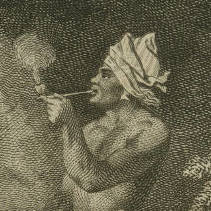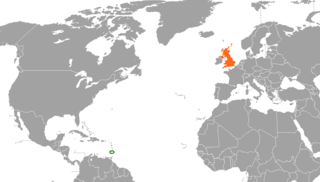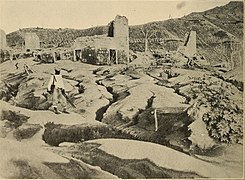The first written records in the history of Dominica began in November 1493, when Christopher Columbus spotted the island. Prior to European contact, Dominica was inhabited by the Arawak. Dominica was a French colony from 1715 until the end of the Seven Years' War in 1763, and then became a British colony from 1763 to 1978. It became an independent nation in 1978.

Saint Lucia is an island country of the West Indies in the eastern Caribbean. The island was previously called Iouanalao and later Hewanorra, names given by the native Arawaks and Caribs (respectively), two Amerindian peoples. Part of the Windward Islands of the Lesser Antilles, it is located north/northeast of the island of Saint Vincent, northwest of Barbados and south of Martinique. It covers a land area of 617 km2 with an estimated population of over 180,000 people as of 2022. The nation's capital and largest city is Castries.

Saint Lucia was inhabited by the Arawak and Kalinago Caribs before European contact in the early 16th century. It was colonized by the British and French in the 17th century and was the subject of several possession changes until 1814, when it was ceded to the British by France for the final time. In 1958, St. Lucia joined the short-lived semi-autonomous West Indies Federation. Saint Lucia was an associated state of the United Kingdom from 1967 to 1979 and then gained full independence on February 22, 1979.

Saint Vincent and the Grenadines is an island country in the Caribbean. It is located in the southeast Windward Islands of the Lesser Antilles, which lie in the West Indies, at the southern end of the eastern border of the Caribbean Sea, where the latter meets the Atlantic Ocean.

The Kalinago, formerly known as Island Caribs or simply Caribs, are an indigenous people of the Lesser Antilles in the Caribbean. They may have been related to the Mainland Caribs (Kalina) of South America, but they spoke an unrelated language known as Island Carib. They also spoke a pidgin language associated with the Mainland Caribs.

Saint Vincent is a volcanic island in the Caribbean. It is the largest island of the country Saint Vincent and the Grenadines and is located in the Caribbean Sea, between Saint Lucia and Grenada. It is composed of partially submerged volcanic mountains. Its largest volcano and the country's highest peak, La Soufrière, is active, with the latest episode of volcanic activity having begun in December 2020 and intensifying in April 2021.
The Leeward Islands are a group of islands situated where the northeastern Caribbean Sea meets the western Atlantic Ocean. Starting with the Virgin Islands east of Puerto Rico, they extend southeast to Guadeloupe and its dependencies. In English, the term Leeward Islands refers to the northern islands of the Lesser Antilles chain. The more southerly part of this chain, starting with Dominica, is called the Windward Islands. Dominica was originally considered a part of the Leeward Islands, but was transferred from the British Leeward Islands to the British Windward Islands in 1940.

The Garifuna people are a people of mixed free African and indigenous American ancestry that originated in the Caribbean island of Saint Vincent and speak Garifuna, an Arawakan language, and Vincentian Creole.

La Soufrière or Soufrière Saint Vincent is an active stratovolcano on the Caribbean island of Saint Vincent in Saint Vincent and the Grenadines. It is the highest peak in Saint Vincent, and has had five recorded explosive eruptions since 1718. The latest eruptive activity began on 27 December 2020 with the slow extrusion of a dome of lava, and culminated in a series of explosive events between 9 and 22 April 2021.

Joseph Chatoyer, also known as Satuye, was a Garifuna (Carib) chief who led a revolt against the British colonial government of Saint Vincent in 1795. Killed that year, he is now considered a national hero of Saint Vincent and the Grenadines, and also of Belize and Costa Rica. Vincentian politician Camillo Gonsalves described him in 2011 as his country's "sole national hero".

Canouan is an island in the Grenadines belonging to Saint Vincent and the Grenadines. It is a small island, measuring only 5.6 by 2 km and has a surface of 7.6 km2. It lies approximately 40 km (25 mi) south of the island of St. Vincent. The population is about 1,700.
Barrouallie is a town located on the island of Saint Vincent. Barrouallie was established by French settlers in 1719, the first European colony on St. Vincent. Once it was the capital of St.Vincent and the Grenadines. With the rest of the island, it passed back and forth between the French and the British, finally remaining in the hands of the latter.
St. Martin's history shares many commonalities with other Caribbean islands. Its earliest inhabitants were Amerindians, followed by Europeans who brought slavery to exploit commercial interests.

Baliceaux is a small, privately owned Caribbean island and is one of the Grenadines chain of islands which lie between the larger islands of Saint Vincent and Grenada. Politically, it is part of the nation of Saint Vincent and the Grenadines.

Carriacou is the largest island of the Grenadines, an archipelago in the Windward Islands chain in the Caribbean Sea.
Sir Robert Baxter Llewelyn (1845–1919) was a colonial administrator in the British Empire.

Afro-Vincentians or Black Vincentians are Vincentians whose ancestry lies within Sub-Saharan Africa.

Saint Vincent and the Grenadines and the United Kingdom have a long history, tracing back to early British settlements and British conflicts with the French during the Colonial era.

La Soufrière, a stratovolcano on the Caribbean island of Saint Vincent in Saint Vincent and the Grenadines, began an effusive eruption on 27 December 2020. On 9 April 2021 there was an explosive eruption, and the volcano "continued to erupt explosively" over the following days, with pyroclastic flows. The activity pattern of the eruption was comparable to that of the event that occurred in 1902, which had a Volcanic Explosivity Index (VEI) of 4. The volcano is known to have erupted 23 times in the last 4,000 years, and had been dormant since 1979.
Vincentian nationality law is regulated by the Saint Vincent Constitution Order of 1979, as amended; the Saint Vincent and the Grenadines Citizenship Act of 1984, and its revisions; and various British Nationality laws. These laws determine who is, or is eligible to be, a national of Saint Vincent and the Grenadines. Vincentian nationality is typically obtained either on the principle of jus soli, i.e. by birth in Saint Vincent and the Grenadines; or under the rules of jus sanguinis, i.e. by birth abroad to parents with Vincentian nationality. It can be granted to persons with an affiliation to the country, or to a permanent resident who has lived in the country for a given period of time through naturalisation. There is not currently a program in Saint Vincent and the Grenadines for persons to acquire nationality through investment in the country. Nationality establishes one's international identity as a member of a sovereign nation. Though it is not synonymous with citizenship, for rights granted under domestic law for domestic purposes, the United Kingdom, and thus the commonwealth, have traditionally used the words interchangeably.






















